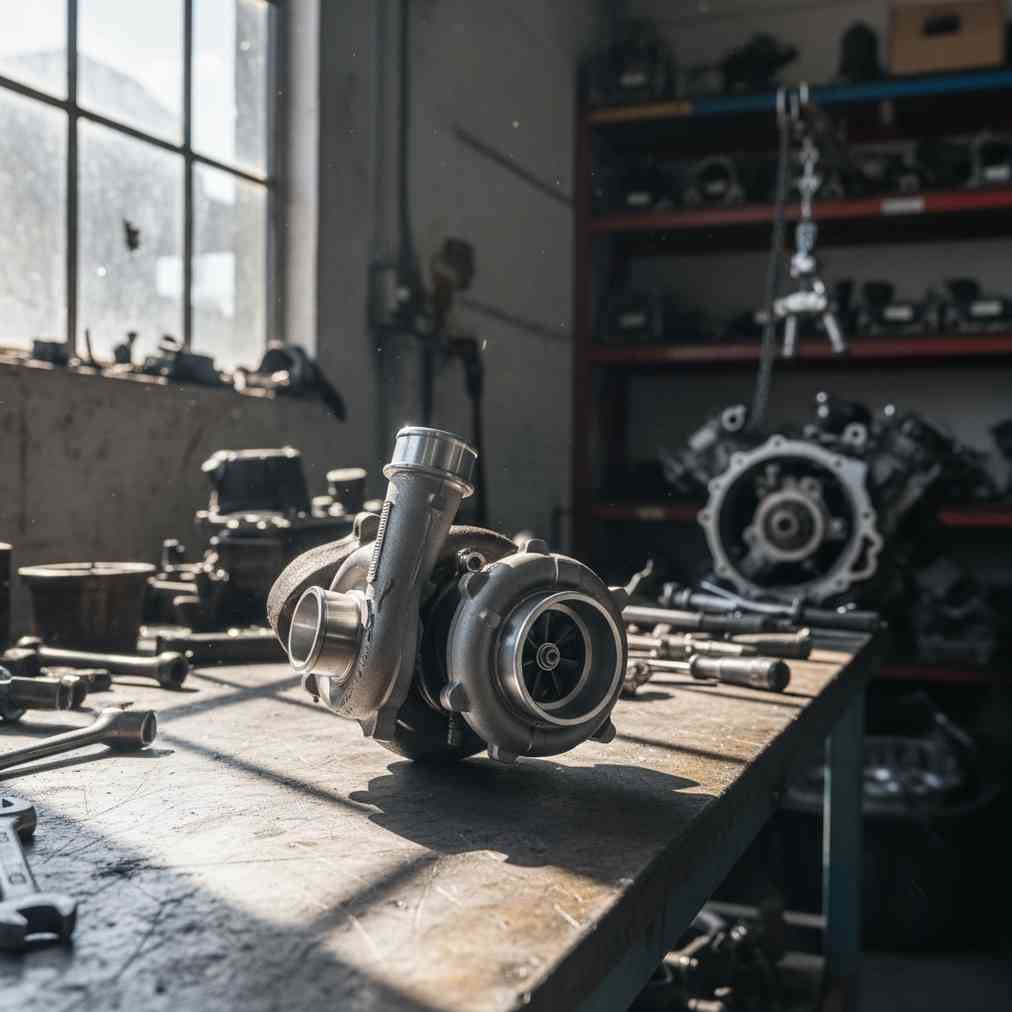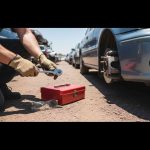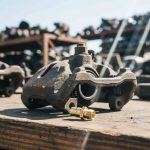The Financial Reality of Used Turbochargers
Purchasing a used turbocharger from a junkyard can be a tempting way to save money on repairs or upgrades. However, it comes with significant risks that must be carefully weighed against the potential cost savings. While some salvageable turbos exist, many require rebuilding or may have hidden damage that leads to premature failure.
Understanding the true cost comparison is crucial. Junkyard turbos can sometimes be found for as little as $50-$150, while a rebuild kit might cost $50-$100. However, OEM turbo replacements, including parts and labor, can cost upwards of $4,500. This dramatic price difference makes used options appear attractive, but the hidden costs often narrow this gap significantly.
Critical Inspection Points for Junkyard Turbochargers
Shaft Play Assessment
Shaft play is the most critical inspection factor when evaluating a used turbocharger. Excessive in-and-out (axial) or side-to-side (radial) movement of the turbocharger shaft indicates worn bearings or internal damage that will lead to rapid failure.
“You shouldn’t see any shaft play, any in-and-out whatsoever, very minimal side-to-side, there’s always going to be some, but keep an eye on the different things.”
- Axial play: Very small amount might be acceptable in some designs
- Radial play: Significant movement means the turbo is compromised
- Loose wheels: If wheels feel floppy, avoid the turbo entirely
- Rotation test: Shaft should spin freely without resistance or grinding
Oil Leak Detection
Oil leaks are a major indicator of turbocharger health. When examining used turbos, focus on these key areas:
- Exhaust side inspection: Significant coked-up oil suggests shot oil rings
- Compressor housing: Oil inside indicates compromised seals
- Positive signs: Relatively dry exhaust side with only carbon buildup
- Housing examination: Check for visible oil residue around joints
For those interested in learning more about comprehensive turbocharger inspection techniques, understanding these oil-related warning signs can save significant money and frustration.
Turbocharger Lifespan and Reliability Factors
The average lifespan of a turbocharger is around 150,000 miles, with proper maintenance potentially extending this to 200,000 miles or more. However, this applies to turbos that have been well-maintained throughout their service life. Used turbos from junkyards have an unknown history, making their remaining lifespan highly unpredictable.
Several factors affect turbocharger longevity:
- Oil change frequency: Regular oil changes are critical for bearing lubrication
- Cooldown periods: Allowing turbos to cool before shutdown prevents oil coking
- Driving habits: Aggressive driving and excessive boost pressure reduce lifespan
- Maintenance quality: Use of proper oil grades and filtration
Understanding how long turbos last under various conditions helps buyers make informed decisions about the risk-reward balance of purchasing used units.
Comprehensive Visual Inspection Checklist
A thorough visual inspection can reveal most potential problems with used turbochargers. Here’s what to examine:
Wheel and Housing Inspection
- Compressor wheel: Check for bent, chipped, or cracked blades
- Turbine wheel: Look for heat damage, discoloration, or blade damage
- Housing contact: Shiny marks on blade edges indicate wheel-to-housing contact
- Spin test: Ensure the compressor wheel spins freely without resistance
- Crack detection: Examine housing for stress cracks or impact damage
Hardware and Compatibility
Beyond the turbocharger itself, several practical considerations affect usability:
- Bolt condition: Exhaust housing bolts may be seized or broken due to heat and rust
- Flange compatibility: Ensure bolt patterns match existing manifold and downpipe
- Mounting hardware: Check condition of all mounting points and brackets
- Line connections: Verify oil and coolant line fittings are undamaged
When searching for turbo parts at junkyards, having a clear checklist prevents costly mistakes and ensures you’re getting a potentially viable unit.
Cost-Benefit Analysis: New vs. Used vs. Remanufactured
| Option | Initial Cost | Expected Lifespan | Warranty | Risk Level |
|---|---|---|---|---|
| Junkyard Used | $50-$150 | Unknown/Variable | None | High |
| Rebuilt Used | $200-$400 | 50,000-100,000 miles | Limited | Medium |
| Remanufactured | $800-$1,500 | 100,000-150,000 miles | 1-2 years | Low |
| OEM New | $2,000-$4,500+ | 150,000-200,000 miles | 3+ years | Very Low |
The true cost calculation must include potential rebuild expenses, installation labor, and the risk of premature failure. While junkyard turbos offer the lowest upfront cost, they often require additional investment that brings total costs closer to remanufactured alternatives.
Expert Insights and Real-World Experiences
Industry professionals and experienced enthusiasts provide valuable perspective on used turbocharger purchases. Expert discussions on turbocharger reliability consistently emphasize that modern turbos with proper maintenance can be extremely durable.
“If you have a shake problem you see the wheels flopping around in there in the turbine and compression wheel don’t rotate in the same time, the best thing to do with this turbocharger is put it in a nice box and throw it in the trash.”
Real-world examples from automotive forums show mixed results. Some enthusiasts report turbos lasting 150,000 miles with high-stress use including track days, but this success required meticulous oil maintenance and proper operating procedures.
When Junkyard Turbos Make Sense
Despite the risks, certain situations favor purchasing used turbochargers from junkyards:
- Budget builds: When initial cost is the primary constraint
- Learning projects: For understanding turbocharger mechanics and rebuilding
- Parts harvesting: Extracting specific components like housings or wheels
- Emergency repairs: When immediate temporary operation is needed
- Race applications: Where expected lifespan is limited regardless
For those exploring when buying used auto parts makes sense, turbochargers represent one of the more challenging components due to their complexity and wear patterns.
Alternative Solutions and Modern Trends
The automotive aftermarket has evolved to provide alternatives that bridge the gap between risky junkyard purchases and expensive OEM replacements:
Remanufactured Turbochargers
- Professional rebuilding: Specialist companies use proper equipment and procedures
- Quality control: Testing and balancing ensure reliable operation
- Warranty coverage: Most offer 12-24 month warranties
- Core exchange programs: Reduce costs through component recycling
Aftermarket New Turbos
New aftermarket turbochargers from reputable manufacturers now offer competitive alternatives to both used and OEM options, often with improved designs and materials at reasonable prices.
Understanding OEM parts quality and availability helps buyers appreciate the trade-offs between original equipment and aftermarket alternatives.
Risk Mitigation Strategies
If you decide to purchase a used turbocharger from a junkyard, several strategies can reduce risk:
- Professional inspection: Have a qualified technician evaluate the unit
- Rebuild planning: Budget for potential rebuild costs upfront
- Supporting system service: Replace oil, filters, and lines when installing
- Proper installation: Follow manufacturer procedures for mounting and connections
- Break-in protocol: Use appropriate procedures for initial operation
For comprehensive guidance on junkyard shopping, explore resources on how smart people save money at junkyards while minimizing risks.
Final Recommendation and Decision Framework
The decision to buy a used turbocharger from a junkyard ultimately depends on your specific situation, mechanical skills, and risk tolerance. For most drivers seeking reliable transportation, the risks outweigh the potential savings.
Choose Junkyard Turbos If:
- Budget is the absolute priority
- You have mechanical expertise for inspection and rebuilding
- The application is temporary or experimental
- You’re comfortable with potential failure risks
Choose New or Remanufactured If:
- Reliability is essential for daily transportation
- You want warranty protection
- Long-term cost-effectiveness is important
- You lack expertise for proper inspection
Remember that turbochargers are complex, precision components operating under extreme conditions. While the initial savings from junkyard purchases can be substantial, the hidden costs of inspection, rebuilding, and potential failure often narrow the gap significantly. For most applications, investing in a properly remanufactured or new turbocharger provides better long-term value and peace of mind.
Whether you choose to explore junkyard options or invest in new components, thorough research and realistic expectations are essential for making the right decision for your specific needs and budget.





Leave a Reply
You must be logged in to post a comment.